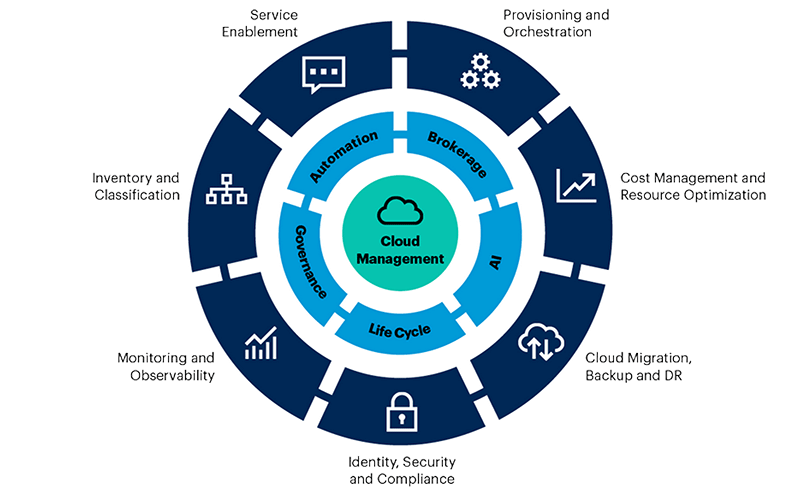
What is cloud management? And how has the definition changed?
At its core, cloud management is all about optimizing the use of private and public clouds with the goal of maximizing efficiency and agility while reducing risk. To get beyond the 100,000-foot marketing definition though, we need to look at the maturity of this market.
Over the past decade, the definitions and the roles of cloud management have evolved. Back in 2011, first-generation cloud management tools such as RightScale and Embotics addressed concerns that infrastructure operations teams expressed about whether the public cloud would take jobs away. These early tools offered a path to control what was new and not well understood. But unfortunately, they failed to meet the needs of the Developers who drove cloud consumption in the first place.
As enterprises increased the use of public clouds, the negative realities of poorly thought through ‘lift and shift’ projects resulted in sky-high costs; therefore, cloud management a few years ago started to refer to tooling that primarily focused on cost control and analytics. Again, many good tools emerged from this space, but they only addressed part of the problem and still left Developers wanting.
The definition is continuing to evolve ‘ and that’s because the problem domain has shifted.
So now, what’s the modern approach to cloud management?
Cloud is now everywhere. It’s on-premises as much as it’s public ‘ and hybrid cloud has quickly become the new normal. This shift pushes development and operations teams closer together but not without lingering friction. Platform engineering teams are looking for better self-service approaches. At the same time, there’s more acknowledgment that operations teams have to enable cloud versus being worried about controlling it. In this modern world, organizations have specific functions and processes that need to happen at the individual “tree” level within the larger “forest” of cross-cloud management.
For example, say a team wants to take advantage of a unique Google or AWS cloud-native service for big data analytics for a specific application. Many such single-cloud decisions can occur across an enterprise. But in aggregate, you also need to think about all the scaling coss-cloud functions in the “forest” such as governance policy, security posture, usage reporting, and cost control.
Additionally, project teams that have spent time in the public cloud have become used to the instant on-demand provisioning of application services. These users refuse to wait days or weeks for on-premises IT teams to manually step through the processes that should be automated.
The ubiquity of hybrid cloud, cloud-native, and trends around cloud repatriation are all key to understanding modern cloud management. In this current context, cloud management platforms must fulfill the needs of an increasingly sophisticated set of user groups:
– Developers need access to ephemeral environments that can be provisioned programmatically independent of where those environments live’ on-prem in VMware or Nutanix or in a public cloud.
– Teams need the flexibility to take advantage of cloud-native constructs such as Kubernetes or public cloud PaaS offerings in while also rethinking their relationship with more traditional bare metal and VM-based apps.
– Security teams need to embed security upstream in the development lifecycle, manage golden image templates, and automate activities such as patching by partnering with Dev and Ops stakeholders.
– Finance groups need visibility into what systems are running on-prem and shouldn’t be forced to navigate multiple hyperscale portals to get what they need in order to pull together show-back models.
Cloud management has become a full-stack conversation as is evidenced by portfolio vendors like VMware and Red Hat acquiring cost management tools and investing in control planes that promise to provide a 100% agnostic nirvana. The question organizations must ask themselves is if they believe that broad portfolio vendors are altruistic in their desire to manage other platforms. The other consideration now top of mind for many existing VMware and Red Hat customers is the impact of the Broadcom and IBM acquisitions of those companies. Articles and analysis are already being published which indicate that the innovation engine at VMware will grind to a halt as Broadcom or another large player scoop them up and they mature into a cash cow.
What do you need in your modern cloud management toolbox?
The cloud management market is growing and evolving quickly. This makes it that much harder to evaluate the plethora of multiple cloud management platforms along with the increasing number of specialized cloud management tools and general-purpose solutions ‘ and find the one that’s right for your cloud environment.
Gartner helps simplify the solution criteria with this graphic and evaluation criteria report that illustrates the critical areas of cloud management. As represented here, cloud management is made up of seven functional areas and five cross-functional attributes.[1] The interrelationships speak for themselves.

Even with this framework in hand, finding the right cloud management tooling for your organization can still be challenging. It’s almost impossible to find one tool to meet all your needs but it is important to limit pain by reducing the panes of glass that get you there.
Gartner utilized this framework in 2019 and 2020 for its Magic Quadrant and Critical Criteria reports on Cloud Management Platforms, but in 2021 hit the pause button. This is an atypical pattern for Gartner but is a reflection of how noisy this market is. One reason for the pause may be the increasing overlap between Cloud Management, Container Management, and Infrastructure Automation tools.
Some organizations have thrown up their hands and attempted to script their way out of the problem. The result, though, is a brittle mess of hand-crafted automation scripts tied to specific clouds and tools. These homegrown platforms ultimately become more expensive to maintain than the commercial offerings designed to abstract complexity in a sustainable way.
You can read the full Gartner Market Guide on Cloud Management Tooling here.
How Morpheus meets modern cloud management challenges
Unlike those early-generation tools or brittle DIY frankenplatforms, Morpheus has a different design center. Morpheus was not born as a CMP. Instead, it was architected to eliminate friction between Dev and Ops, simplify the consumption of infrastructure resources, and accelerate application provisioning to support business transformation. It’s the only platform designed to meet the needs of today’s platform engineering teams.
‘ Self-Service interface for cradle to grave app lifecycle management
‘ Loosely coupled set of abstractions to maximize flexibility
‘ API-driven architecture balancing out-of-the-box integration with extensibility
‘ Agnostic to clouds, infrastructure, and supporting technologies
‘ Fine-grained service definition to support emerging app platforms
Morpheus has developed a normalized view of IT that spans hybrid clouds and the roles that consume those clouds to meet the needs of developers, platform teams, security teams, finance, and more. All are “equal citizens” under our persona-based cloud management platform design.
Why is Morpheus different? We were designed by DevOps pros as part of an internal application factory that needed agility, flexibility, and control. They couldn’t find the perfect tool, so they built one. It’s why we combine the industry’s best cloud management with open container orchestration and powerful infrastructure automation. Our approach is modern, hybrid, and forward-leaning. See for yourself. Request a Morpheus demo today.
[1] Gartner; Solution Criteria for Cloud Management Tools; August 2020